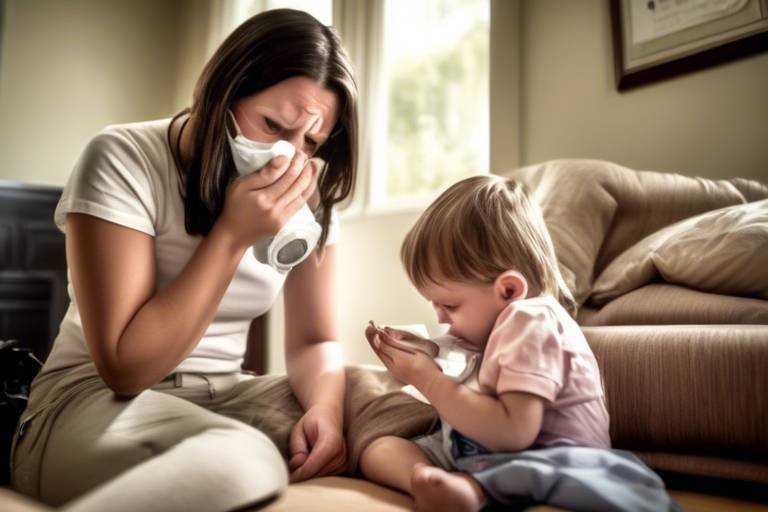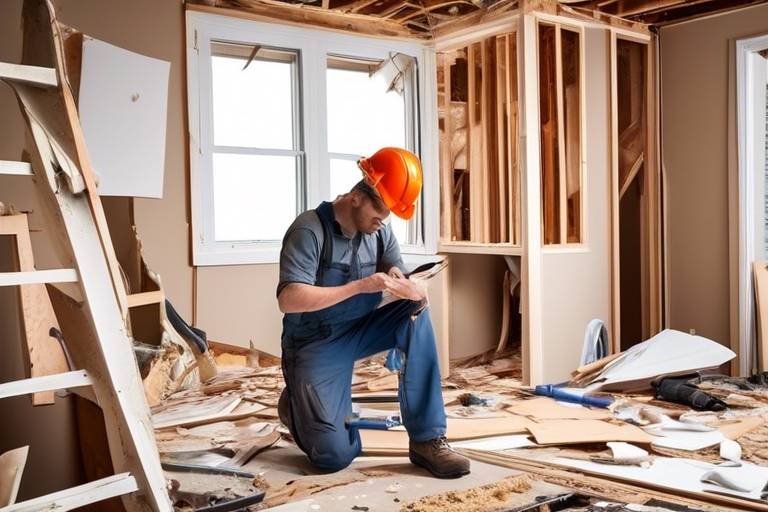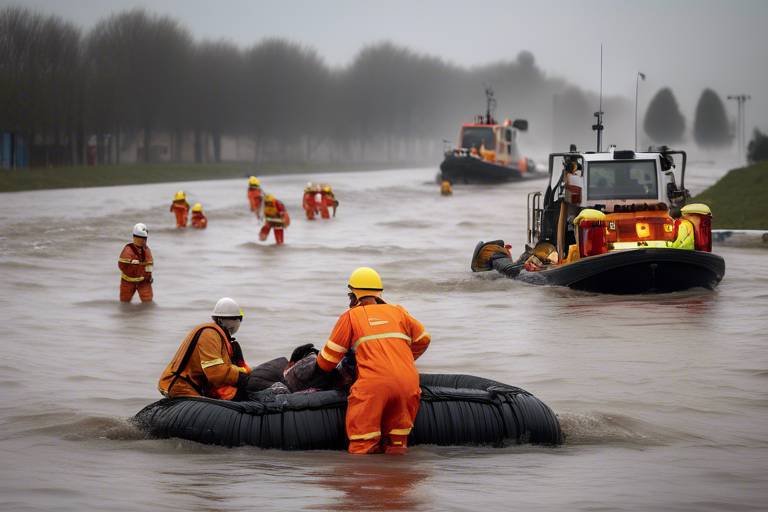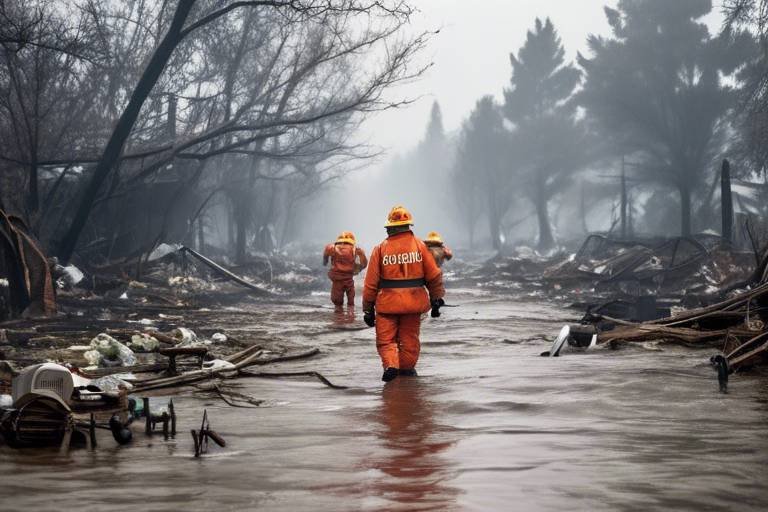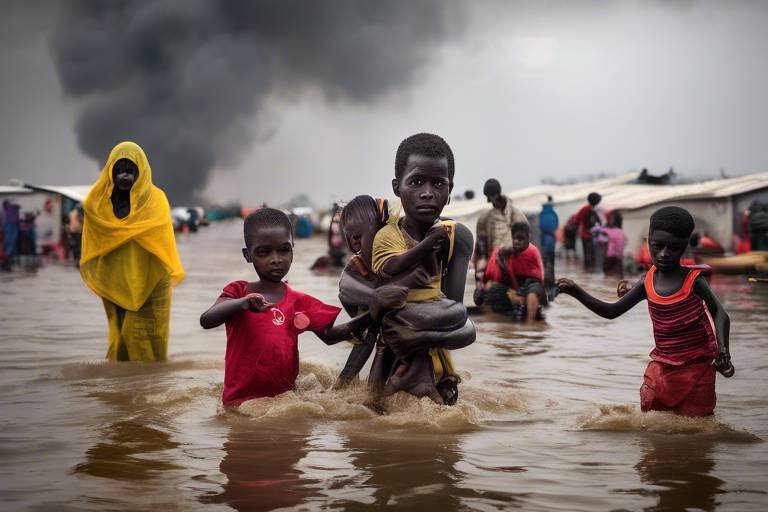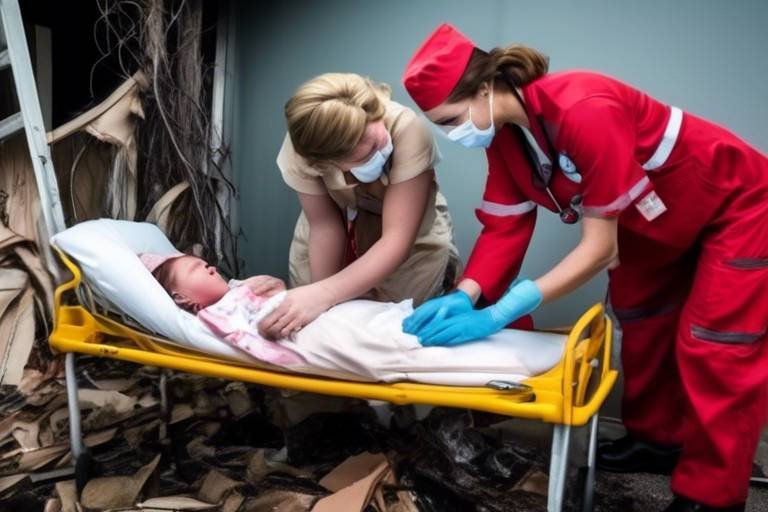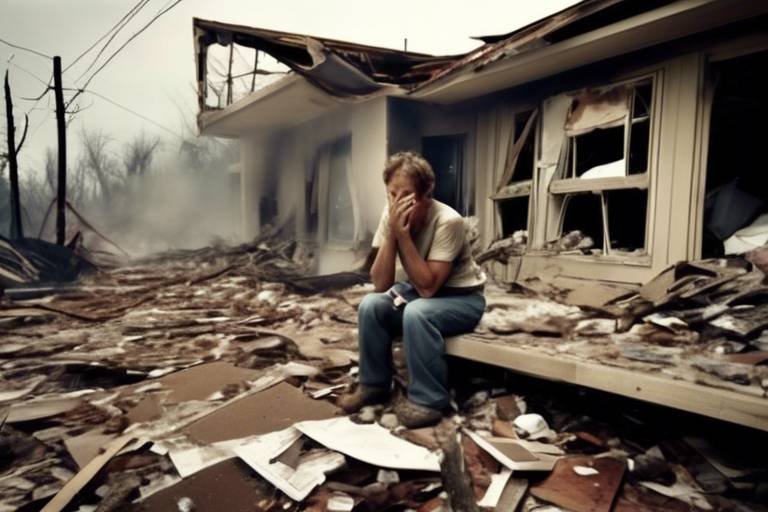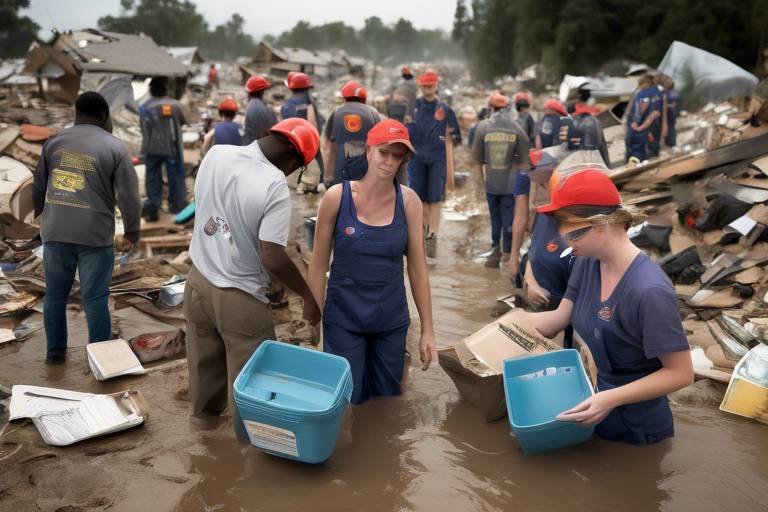Your Guide to Emergency Preparedness for Toddlers
In today's unpredictable world, being prepared for emergencies is not just a smart choice; it's a necessity, especially when it comes to our little ones. Imagine a situation where you have to act quickly—what would you do if a natural disaster struck or if there was a sudden emergency? Preparing your toddler for such scenarios can seem daunting, but it doesn't have to be! This article provides essential tips and strategies for parents to effectively prepare their toddlers for emergencies, ensuring their safety and well-being in unexpected situations. By fostering a sense of security and awareness, you can help your child navigate through chaotic times with confidence.
Recognizing the various types of emergencies that can occur is crucial. Emergencies can range from natural disasters like earthquakes and floods to man-made situations such as fires or unexpected medical issues. Each of these scenarios can have a profound impact on toddlers, who may not fully understand what is happening around them. Understanding the potential risks allows parents to tailor their preparations effectively. For example, if you live in an area prone to hurricanes, knowing how to secure your home and what to do when a storm approaches is vital. Similarly, teaching your toddler about fire safety can be lifesaving. Not every emergency is the same, but having a broad understanding of potential threats ensures you're ready for anything that comes your way.
A well-structured emergency plan is vital for every family. It’s not just about having a plan; it’s about making sure your toddler understands it. Start by discussing different scenarios with your child in a calm and reassuring manner. Here are some key steps to create an effective plan tailored for toddlers:
- Identify potential emergencies based on your location.
- Discuss the importance of staying calm and following instructions.
- Designate a safe meeting place outside your home.
- Ensure your toddler knows how to reach you or another trusted adult.
By involving your toddler in the planning process, you not only equip them with knowledge but also empower them to take part in their own safety. Remember, the goal is to make them feel secure, not scared!
Engaging toddlers in the planning process can help them understand the importance of preparedness. But how do you make this process fun and educational? Incorporate games and role-playing to teach them about emergency procedures. For instance, you can play a game where you pretend to be firefighters or rescue workers. This not only makes learning enjoyable but also helps them remember crucial steps they need to take during real emergencies. Use stories or cartoons that illustrate emergency situations, and ask your toddler what they would do in those scenarios. This way, they learn while having fun!
Using age-appropriate language is key to effective communication. Toddlers grasp concepts better when they are presented in simple terms. For example, instead of saying “evacuate,” you might say “let’s go outside to safety.” By breaking down complex ideas into simple, relatable concepts, you can help your toddler understand what to do in an emergency. Use visuals like drawings of safe places or emergency kits to reinforce these ideas. Remember, the more they understand, the less likely they are to panic when an emergency occurs.
Regular practice drills can reinforce your emergency plan. Just like fire drills at school, practicing at home can help your toddler remember their roles during an emergency. Make these drills fun by turning them into a game. For instance, you can set a timer and see how quickly your family can gather at the designated meeting spot. Celebrate their successes! This not only builds confidence but also encourages them to take the drills seriously. Consistent practice helps solidify their understanding and prepares them for real-life situations.
Having a well-stocked emergency kit is essential for any family. For toddlers, this kit should include items that ensure their comfort and safety during stressful times. Here’s what you should consider including:
| Item | Purpose |
|---|---|
| Diapers and Wipes | For hygiene and comfort |
| Favorite Toy or Blanket | To provide emotional comfort |
| Snacks and Water | To keep them nourished |
| First Aid Supplies | For minor injuries |
By having a toddler-specific emergency kit, you can ensure that your child has everything they need to feel safe and secure during an emergency. Remember to check and update the kit regularly to keep it stocked with fresh supplies.
Equipping toddlers with basic safety skills is crucial. Teaching them simple safety lessons can foster independence and confidence in emergencies. Start with the basics: identifying safe spaces in their environment. Where can they go if they feel scared? Help them recognize safe locations at home and in public, like the neighbor's house or a designated safe zone in a park. This knowledge empowers them and gives them a sense of control.
Teaching toddlers to identify safe spaces in their environment can empower them during emergencies. You can create a fun scavenger hunt where they find safe spots around your home or neighborhood. Encourage them to remember these places and practice going there together. This not only helps them learn but also builds a strong foundation for their understanding of safety.
Ensuring toddlers know important contact information is vital. Teach them their parents' names, phone numbers, and addresses in a memorable way. Use songs or rhymes to make it easier for them to remember. For example: “If you get lost, just call Mom, she loves you lots, she’ll come along!” This playful approach makes learning essential information enjoyable and less intimidating.
Q: How can I make emergency preparedness fun for my toddler?
A: Use games, role-playing, and storytelling to engage your toddler in the learning process. Making it enjoyable helps them remember what they learn.
Q: What should I include in my toddler's emergency kit?
A: Include items like diapers, wipes, snacks, a favorite toy, and first aid supplies to ensure their comfort and safety during emergencies.
Q: How often should I practice emergency drills with my toddler?
A: Regular practice is key! Aim for at least once every few months, or whenever you feel your child needs a refresher.
Q: How can I teach my toddler about safe spaces?
A: Create a scavenger hunt for them to find safe spots in your home or neighborhood, reinforcing the concept through fun and interactive activities.

Understanding Emergencies
When we think about emergencies, our minds often jump to dramatic scenarios like fires, earthquakes, or severe weather. But the truth is, emergencies come in many shapes and sizes, and they can affect our little ones in unexpected ways. Understanding the different types of emergencies is crucial for parents, especially when it comes to toddlers who may not fully comprehend what’s happening around them. From natural disasters to medical emergencies, being prepared means knowing what to expect and how to react.
Let’s break down some common emergencies that could impact your toddler:
- Natural Disasters: Events like hurricanes, tornadoes, and floods can disrupt lives in an instant. For toddlers, these situations can be confusing and frightening.
- Fires: House fires can occur due to various reasons, and understanding fire safety is vital. Toddlers need to learn how to react if they ever find themselves in such a scary situation.
- Medical Emergencies: From minor injuries to sudden illnesses, knowing how to respond to health-related emergencies can save lives.
- Accidents: Everyday accidents, like falls or choking, are also emergencies that parents must be prepared for. Teaching toddlers about safety can help minimize risks.
Each of these emergencies can have a profound impact on your toddler’s emotional and physical well-being. Imagine your child waking up to the sound of a siren or feeling the ground shake beneath them; these experiences can be overwhelming. It’s essential to create a sense of security by preparing them for the unexpected. As parents, we must not only equip ourselves with knowledge but also share this understanding with our children in a way that’s relatable and engaging.
One effective method to help toddlers grasp the concept of emergencies is through storytelling. Create simple, relatable stories that involve characters facing various emergencies and how they respond. This approach not only makes the learning process enjoyable but also helps children visualize what might happen in real-life situations. By framing emergencies in a way that toddlers can understand, we empower them to react appropriately when faced with challenges.
Moreover, it’s important to recognize that toddlers are naturally curious and often mimic the behaviors of adults. By modeling calm and collected responses during discussions about emergencies, you provide a framework for how they should react when faced with real-life situations. Remember, the goal is not to instill fear but to foster a sense of preparedness and resilience.
In conclusion, understanding emergencies is the first step in ensuring your toddler's safety. By recognizing the types of emergencies that could arise and preparing your child through engaging methods, you can cultivate a sense of security and readiness. After all, a well-prepared parent is the best asset in any emergency scenario!

Creating an Emergency Plan
When it comes to ensuring the safety of your little ones, creating an effective emergency plan is as essential as packing their favorite snacks for a road trip! Think of it as a roadmap that guides your family through unexpected situations. A well-structured emergency plan not only prepares you for various scenarios but also instills a sense of security in your toddler. So, where do you start?
First and foremost, gather your family together for a fun brainstorming session. This is not just about writing down procedures; it's about making your toddler feel included and valued. Explain to them, in simple terms, what emergencies might look like. Whether it's a fire, a storm, or even getting lost in a store, understanding these concepts can help toddlers feel more secure. You can use relatable analogies, like comparing a fire drill to a superhero training session, where everyone has a role to play!
Next, outline specific actions for different emergencies. For instance, if there’s a fire, your plan should include:
- Identifying exits in your home.
- Knowing where to meet outside.
- Practicing how to stay low to the ground.
By breaking down these steps, you help your toddler visualize what needs to be done. It’s important to keep the language simple and clear. Instead of saying, “evacuate,” you might say, “let’s go outside to our safe spot!” This makes it easier for them to understand and remember.
Once you have the actions outlined, create a visual representation of the plan. You could use colorful drawings or a simple chart that illustrates the steps. Hang it somewhere visible, like on the fridge, so that your toddler can see it daily. This not only serves as a reminder but also makes them feel like they are part of something important. You might even consider designing a fun song together that includes the steps of your emergency plan—this will make it memorable!
Moreover, regular practice is key. Just like how toddlers enjoy repeating their favorite bedtime stories, they will appreciate going over the emergency plan too. Schedule practice drills in a playful manner, turning them into a game. For example, you could pretend to be firefighters and race to the designated meeting spot. The more fun you make it, the more likely they are to remember what to do when it really counts.
Finally, don’t forget to involve your toddler in discussions about safety outside the home. Talk about what to do if they get lost in a store or how to ask a trusted adult for help. Reinforcing these lessons through role-play can empower them and build their confidence.
In summary, creating an emergency plan for your toddlers is not just a list of actions; it’s a bonding experience that teaches them valuable lessons while ensuring their safety. By making the process engaging and educational, you prepare them to handle emergencies with a brave heart and a clear mind.

Involving Your Toddler
When it comes to emergency preparedness, involving your toddler can be a game-changer! Think of it as a fun adventure rather than a daunting task. Kids are naturally curious, and by engaging them in the planning process, you can turn what might seem like a scary topic into an exciting learning experience. So, how do you get started? First, make it a family affair! Gather everyone around and discuss what emergencies might happen, like a fire, a storm, or even getting lost in a store. Use simple, relatable examples that they can understand. For instance, you might say, “What would we do if there was a big storm and we had to stay safe at home?”
Next, involve them in creating your emergency plan. You can draw a simple map of your home and highlight safe spots where they can go if something happens. This could be a designated meeting place in the house or a neighbor's home. Let them color the map or add stickers to make it visually appealing. You could even create a little story around the plan. For example, “If we hear a loud noise, we can go to the living room and wait for Mommy or Daddy to come and get us!” This way, they start to associate safety with fun rather than fear.
Another fantastic way to involve your toddler is through role-playing. Create scenarios where they get to practice what to do in different emergencies. For example, you might pretend there’s a fire and practice how to exit the house safely. Make it playful—perhaps they can wear a firefighter hat or carry a toy fire extinguisher! The more they practice, the more confident they will feel. Plus, it helps them remember what to do when the real situation arises.
Don't forget to celebrate their participation! After each practice session, give them a sticker or a little reward. This positive reinforcement will not only make them feel accomplished but also encourage them to take the process seriously. Remember, the goal is to empower them, so use phrases like, “You did such a great job helping us prepare!” This instills a sense of responsibility and makes them feel like they are part of the team.
Incorporating games can also be a fantastic way to teach your toddler about emergency preparedness. For instance, you could play a game where they have to find items in your emergency kit or identify safe spaces in your home. Make it a scavenger hunt! This method not only makes learning fun but also helps them remember important information in a relaxed environment.
Finally, always keep the lines of communication open. Encourage your toddler to ask questions about emergencies and listen to their thoughts and feelings. They might have fears or misconceptions that you can address. By validating their feelings and providing reassurance, you help build their confidence. Remember, the more involved they feel, the more prepared they will be when it truly matters!

Simple Language and Concepts
When it comes to preparing your toddler for emergencies, using simple language and concepts is absolutely essential. Toddlers are like little sponges, soaking up information, but their understanding of the world is still quite limited. Imagine trying to explain a complex idea to a young child; it can feel like trying to teach a cat to fetch! Instead, we need to break things down into bite-sized, digestible pieces that they can easily grasp.
One effective way to communicate emergency concepts is to use everyday language that your toddler hears regularly. For instance, instead of saying “evacuate,” you might say “let’s go outside quickly.” This not only makes it easier for them to understand but also makes the situation feel less scary. It’s all about turning something potentially frightening into something manageable and even a little fun!
Another strategy is to use visual aids and storytelling. Kids love stories, and weaving emergency preparedness into a tale can capture their attention. You could create a story about a brave little bear who knows exactly what to do when there’s a storm. By using characters they can relate to, you can help them understand the importance of safety without overwhelming them.
Moreover, using analogies can be incredibly helpful. For example, you might compare an emergency plan to a treasure map. Just like a treasure map shows you where to go to find something special, an emergency plan shows you where to go to be safe. This kind of comparison can help toddlers visualize the importance of having a plan in a way that resonates with them.
Here are some key concepts to focus on when communicating with your toddler:
- Stay Calm: Teach them that it’s okay to feel scared, but it’s important to stay calm.
- Follow Directions: Reinforce the idea that listening to adults during an emergency is crucial.
- Safe Spots: Help them identify safe places at home, like a designated room or corner.
- Emergency Numbers: Use simple songs or rhymes to help them remember important phone numbers.
By keeping the language simple and the concepts relatable, you’re not just preparing your toddler for emergencies—you’re also building their confidence. When they understand what to do, they are less likely to panic and more likely to take action. Remember, the goal is to make learning about emergencies a positive experience, so sprinkle in some fun and creativity along the way!

Practice Drills
When it comes to emergency preparedness, practice makes perfect! Think of practice drills as the dress rehearsal for a big show. Just like actors need to run through their lines to feel confident, toddlers need to participate in drills to understand what to do in case of an emergency. Engaging your little ones in these activities not only helps them learn but also makes the process enjoyable and less intimidating. It’s essential to create a routine where these drills are a regular part of your family’s life, so they become second nature.
Start by choosing a specific type of emergency to practice, such as a fire drill or a severe weather scenario. Gather your family and explain the drill in simple terms. For example, you might say, “If we hear the smoke alarm, we need to go outside to the big tree in the yard.” Using clear and straightforward language helps toddlers grasp the situation without feeling overwhelmed. You can even turn it into a game! Pretend you hear the alarm and encourage your toddler to race to the designated safe spot. This not only makes it fun but also reinforces the importance of acting quickly.
Consistency is key! Schedule these practice drills regularly, perhaps once a month, to keep the information fresh in your toddler’s mind. You can create a drill calendar and hang it somewhere visible, like the fridge. This way, your child can look forward to the next drill, turning it into a family event. Remember, repetition helps solidify their understanding and builds their confidence. As they become more comfortable with the drills, you can gradually introduce more complex scenarios. This could include practicing what to do if they get separated from you in a crowded place or what to do if they hear a loud noise outside.
Incorporating storytelling can also enhance the learning experience. You might read a book about emergencies or watch a kid-friendly video that illustrates safety procedures. Afterward, discuss the story and relate it to your practice drills. Ask questions like, “What would you do if you heard a loud noise?” This not only reinforces the lessons but also encourages critical thinking. Remember, the goal is to empower your toddler, making them feel capable and secure in their ability to handle unexpected situations.
Finally, celebrate their participation! After each drill, offer praise and perhaps a small reward, like a sticker or extra playtime. This positive reinforcement will encourage them to take these drills seriously while also making them feel proud of their achievements. By turning emergency preparedness into a fun and engaging activity, you’re not just teaching your toddler to respond during a crisis but also building a foundation of safety awareness that will last a lifetime.
Q: How often should we practice emergency drills with our toddler?
A: It's recommended to practice emergency drills at least once a month. Regular practice helps reinforce what they’ve learned and makes it easier for them to remember what to do in a real emergency.
Q: What should I do if my toddler is scared during a drill?
A: If your toddler seems scared, take a moment to reassure them. Explain that these drills are meant to keep everyone safe and that it’s okay to feel nervous. You can also modify the drill to make it less intimidating and more fun.
Q: How can I make emergency drills fun for my toddler?
A: Incorporate games, storytelling, and rewards. Turn the drill into a race or a treasure hunt where they have to find safe spots. Use props or costumes to make the experience more engaging!
Q: Should I explain every detail of the emergency plan to my toddler?
A: No, it’s best to keep explanations simple and age-appropriate. Focus on the key actions they need to take, using language they can understand.

Emergency Kits for Toddlers
When it comes to keeping our little ones safe during emergencies, a well-stocked emergency kit is not just a luxury; it's a necessity. Think of it as your toddler's superhero sidekick, ready to swoop in and save the day when unexpected situations arise. But what exactly should be included in this crucial kit? Let's dive into the essentials that will ensure your toddler remains comfortable and secure when the unexpected occurs.
First and foremost, comfort items are essential. Toddlers thrive on familiarity, and having their favorite blanket or stuffed animal can provide a sense of security in stressful situations. In addition, consider including a few small toys or books to keep them entertained. After all, a little distraction can go a long way in helping them cope with the chaos around them.
Now, let's talk about the basics: every emergency kit should include items that cater to your toddler's immediate needs. This includes:
- Non-perishable snacks: Think of things like granola bars, dried fruits, or crackers that are easy to pack and provide energy.
- Water: Staying hydrated is crucial. Make sure to have a few small bottles or a collapsible water container.
- First aid supplies: Band-aids, antiseptic wipes, and any necessary medications should be readily available. It's always good to be prepared for minor scrapes and bruises.
Moreover, it's wise to have a few hygiene items in the kit. Toddlers can be messy, and having wipes, hand sanitizer, and a small pack of diapers (if applicable) can make a world of difference in maintaining cleanliness and comfort.
Another crucial aspect is a communication tool. A small, waterproof notepad and a pen can be invaluable. You can jot down important information, such as emergency contacts or your toddler's favorite phrases to help them understand what's happening. This not only keeps your child informed but also fosters a sense of involvement in the situation.
Finally, don’t forget to personalize your kit. Every child is unique, and their needs may vary. Consider including items like a pacifier, a favorite snack, or even a comfort item specific to your toddler. The goal is to create a kit that feels tailored to them, making them feel more secure and at ease.
In conclusion, assembling an emergency kit for toddlers is a proactive step that every parent should take. By including comfort items, essentials for their immediate needs, hygiene products, communication tools, and personalized touches, you can create a safety net that will help your little one navigate through any emergency with confidence and calmness.
1. How often should I check my toddler's emergency kit?
It's a good practice to review the kit every six months. This ensures that food items are not expired, and any necessary adjustments can be made as your child grows.
2. What if my toddler has allergies?
Be sure to customize the kit according to your child's allergies. Avoid any snacks or products that could trigger an allergic reaction, and consider having an emergency plan in place for allergic reactions.
3. Can I involve my toddler in preparing the kit?
Absolutely! Involving your toddler can make the process fun and educational. Let them choose a few comfort items or snacks to include, helping them understand the importance of being prepared.

Teaching Safety Skills
Equipping toddlers with basic safety skills is not just a precaution; it's a vital part of their development. Think of it as giving them a toolbox filled with essential tools they can use when faced with unexpected situations. Just like learning to ride a bike, mastering safety skills takes practice, patience, and a sprinkle of fun!
One of the most important skills toddlers can learn is how to identify safe spaces. Imagine your home as a fortress, filled with cozy corners where they can seek refuge during a storm or an unexpected event. Start by walking through your home together, pointing out safe areas like the living room or a designated safe spot in their bedroom. You can say, “This is our safe place! If something happens, we can come here and feel secure.” Reinforcing these concepts helps them develop a sense of security and awareness of their surroundings.
Moreover, teaching them emergency contact information is crucial. It’s like giving them a secret code to connect with you when they need help. Use playful methods to help them remember your names, phone numbers, and addresses. For example, you could create a fun song or rhyme that incorporates this information. Kids love music, and it makes memorization easier. You might say, “Let’s sing our phone number together! It’s like a little song just for us!” This not only makes it memorable but also enjoyable.
In addition to these skills, it’s essential to introduce the concept of “stranger danger.” While it’s important not to instill fear, teaching them to be cautious around unfamiliar people is necessary. You could role-play different scenarios: “What would you do if someone you don’t know asks you to come with them?” This interactive approach makes it easier for them to understand the concept without feeling scared. Always reassure them that it’s okay to say no and to seek help from a trusted adult.
Finally, remember that repetition is key. Just like any other skill, toddlers need to practice what they learn. Consider conducting regular “safety days” where you review these skills together. You could set up mini-scenarios where they can practice identifying safe spaces, remembering contact information, and responding to strangers. Make it a game! The more they practice, the more confident they will become.
In conclusion, teaching safety skills to toddlers is not only about preparing them for emergencies but also about fostering a sense of independence and confidence. By engaging them in fun, interactive ways, you’re not just imparting knowledge; you’re building a foundation for a lifetime of safety awareness.
Q: At what age should I start teaching my toddler safety skills?
A: It's never too early to start! Even toddlers as young as two can begin to learn basic safety concepts. Tailor the lessons to their developmental stage.
Q: How can I make safety drills fun for my toddler?
A: Use games, songs, and role-playing scenarios. Turn drills into adventures where they can be heroes in their own story!
Q: What if my toddler doesn't remember the safety information?
A: Repetition is key! Keep practicing in a fun way, and consider using visual aids like charts or drawings that they can relate to.
Q: Should I discuss emergencies in detail with my toddler?
A: Focus on simple concepts rather than overwhelming details. Use age-appropriate language to ensure they understand without becoming fearful.

Identifying Safe Spaces
Teaching your toddler to identify safe spaces is not just a clever idea; it's a vital skill that can empower them during emergencies. Imagine your little one, in a moment of panic, knowing exactly where to go to feel secure! This knowledge can turn a scary situation into a manageable one. To start, it's essential to explain to your child what a safe space is. You can say something like, “A safe space is a place where we can go to be safe and calm.” This simple definition sets the stage for them to understand the concept.
Begin by walking through your home with your toddler, pointing out various locations that can serve as safe spaces. For instance, the living room might be a good spot if it's away from windows, while the bathroom can be a safe haven during severe weather. Make it interactive; ask them questions like, “Where do you think we should go if there’s a loud noise outside?” Encouraging them to think critically about their environment will help them internalize these concepts.
When discussing safe spaces, it’s also crucial to extend the conversation beyond your home. Talk about safe spots in public places, like a designated meeting point at the park or the information desk in a mall. You can create a fun game out of this by pretending to be in different scenarios and asking your toddler where they would go. This not only reinforces the idea but also makes it enjoyable!
To further enhance their understanding, consider creating a visual aid. You could draw a simple map of your home and label the safe spaces. Use bright colors and fun stickers to make it appealing. Hang this map somewhere visible, like on the fridge, so your toddler can refer to it whenever they want. It’s a great way to keep the conversation going and reinforce their learning.
Lastly, remember that repetition is key. Regularly revisit the idea of safe spaces during family discussions or playtime. This will help solidify the concept in their minds, making it second nature for them. By instilling this knowledge, you’re not just preparing them for emergencies; you’re also fostering a sense of security and confidence that will last a lifetime.
1. Why is it important for toddlers to know about safe spaces?
Understanding safe spaces empowers toddlers to react calmly in emergencies, helping them feel secure and confident.
2. How can I make learning about safe spaces fun for my toddler?
Engage them in games, use visual aids like maps, and involve them in discussions about different environments to make it enjoyable.
3. At what age should I start teaching my child about safe spaces?
It's beneficial to start as early as possible, even as young as two or three years old, using simple language and concepts.
4. How often should I revisit the topic of safe spaces with my toddler?
Regular discussions, at least once a month or during family outings, can help reinforce their understanding and keep the information fresh.

Emergency Contact Information
Ensuring your toddler knows important contact information is a vital aspect of emergency preparedness. Imagine a scenario where your little one gets separated from you in a crowded place. The thought alone can make any parent’s heart race! That's why teaching them to recognize and remember key details, such as your names, phone numbers, and addresses, can be a lifesaver—literally. But how do you go about this in a way that resonates with a toddler's understanding?
First and foremost, it’s essential to keep the information simple and relatable. Instead of overwhelming them with a long string of numbers, break it down into manageable pieces. For example, you can teach them your first names, followed by an easy-to-remember phone number. You might say, “If you ever need help, just ask someone to call Mommy at 123-456-7890!” This approach not only makes it easier for them to remember but also instills a sense of confidence in their ability to reach out for help.
To make learning this information more engaging, consider using fun activities. You could create a colorful flashcard with your contact details and illustrations that your toddler can relate to. For instance, you might draw a picture of your house next to your address. This visual aid can help them associate the numbers with a familiar place, making it more memorable. You can also turn it into a game where they practice saying your names and numbers aloud, perhaps even pretending to call you on a toy phone!
Another effective strategy is to incorporate songs or rhymes. Children love music, and setting the information to a catchy tune can make it stick in their minds. Think of it as creating a little jingle that they can sing whenever they need to recall the information. For example, “Mommy’s number is one-two-three, four-five-six, seven-eight-nine-oh, that’s how you reach me, you know!”
Additionally, consider role-playing different scenarios where your toddler might need to use this information. You could simulate situations where they might get lost in a store or a park. By practicing what to do and who to ask for help, you can reinforce their understanding of how to use the contact information effectively. This not only builds their confidence but also helps them understand the importance of staying calm and seeking assistance when needed.
Finally, regularly revisiting this information is crucial. Just like any other lesson, repetition is key to retention. Make it a part of your routine—perhaps during car rides or while playing together. The more often your toddler hears and practices this information, the more likely they are to remember it in an actual emergency.
In summary, teaching your toddler emergency contact information doesn’t have to be a daunting task. By using simple language, engaging activities, and consistent practice, you can empower your child with the knowledge they need to seek help when it matters most. Remember, you’re not just giving them numbers; you’re equipping them with a sense of safety and independence that will serve them well throughout their lives.
- What age should I start teaching my toddler emergency contact information? It's best to start as early as possible, around ages 3 to 4, when they can begin to understand simple concepts.
- How can I make learning fun for my toddler? Use games, songs, and visual aids to engage their interest and help them remember important information.
- What if my toddler forgets the information? Regularly revisit and practice the information in a relaxed setting to reinforce their learning.
- Should I teach my toddler to memorize my full address? Yes, but simplify it by breaking it down into parts and associating it with familiar landmarks.
Frequently Asked Questions
- What types of emergencies should I prepare for with my toddler?
It's important to consider various emergencies such as natural disasters (like earthquakes or floods), fire incidents, medical emergencies, and even situations like getting lost. Each of these can have different impacts on toddlers, so being aware and prepared is key!
- How can I create an effective emergency plan for my family?
Start by discussing potential emergencies with your family, then outline clear steps for what to do in each scenario. Make sure to include your toddler in the conversation, using simple language they can understand. Practice the plan regularly so it becomes second nature!
- Why is it important to involve my toddler in emergency planning?
Involving your toddler not only helps them understand the importance of being prepared but also makes the process fun! By engaging them in the planning, they are more likely to remember what to do during an actual emergency.
- What should I include in a toddler-specific emergency kit?
Your emergency kit should include items like snacks, water, a favorite toy, a blanket, and any necessary medications. Don't forget to add comfort items that can help soothe your toddler during stressful times!
- How can I teach my toddler basic safety skills?
Start with simple concepts, like identifying safe spaces in your home or neighborhood. Use games and role-playing to make learning fun! Teaching them their full name, your contact information, and what to do in emergencies can empower them and build their confidence.
- What are some effective ways to practice emergency drills with toddlers?
Keep drills engaging by turning them into a game! Use stories or puppets to illustrate what to do in different scenarios. Regular practice helps toddlers remember their roles, so make it a fun family activity!
- How can I simplify emergency concepts for my toddler?
Use age-appropriate language and relatable examples. Instead of saying "evacuate," you might say "let's go to our safe spot." The goal is to keep it simple and relatable so they can easily understand and remember!


